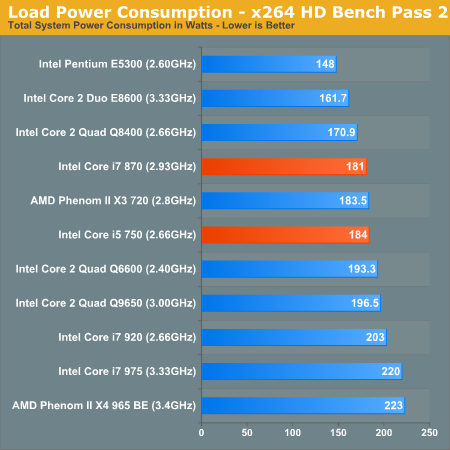Intel's Core i7 870 & i5 750, Lynnfield: Harder, Better, Faster Stronger
by Anand Lal Shimpi on September 8, 2009 12:00 AM EST- Posted in
- CPUs
Power Consumption
If you'll remember back to last year's Nehalem coverage I made a point to mention that the Nehalem architecture, thanks to its PCU and power gate transistors, was the most power efficient of the high end options. The lower the TDP, the more important power efficiency is and thus it's no surprise to see Lynnfield truly impress when it comes to power consumption:

At idle the Core i5 and Core i7 870 use less power than any other processor we've ever tested. Note that these idle power figures include an idling GeForce GTX 280. With a lower power graphics card, you could easily get to idle power consumption around 60W. Once we start seeing on-package GPUs, total system power consumption should drop even further.

Under load the Core i5 and Core i7 870 continue to impress. They both draw less power than a Q6600 or a Q9650, all the while outperforming the two. Power consumption is also noticeably lower than Bloomfield.
These things are fast and smart with power. Just wait until Nehalem goes below 65W...










343 Comments
View All Comments
Shadowmaster625 - Tuesday, September 8, 2009 - link
Intel releases yet another new socket type, offering negligible performance enhancements vs socket 775. Soon they will obsolete another socket type still in use. And this is a good thing? I'm still dealing with the fallout from the socket 478...DJMiggy - Tuesday, September 8, 2009 - link
Thanks! Some good info! Now to decide what to do...Rabman - Tuesday, September 8, 2009 - link
Full disclusre -- I work for AMD, my comments are my own and do not reflect my employer, etc.A clarification on Windows 7's Core Parking feature -- it doesn't actually "[look] at the performance penalty from migrating a thread from one core to another". Rather, Core Parking was designed as a power saving feature for multi-core server machines, and is only enabled on Windows 7 client SKUs where HT is present (I won't get into specifics as to why this decision was made). The side benefit for processors with HT is that the hyperthreads can be parked so the Windows scheduler will spread threads across the "real" cores first, resulting in better performance characteristics.
rbbot - Tuesday, September 8, 2009 - link
That implies that it would have a negative effect on the chances of turbo mode engaging. On other OS, pure random chance would sometimes assign a waking thread to the hyper-core of the one already executing at full pelt. However, this means that on Windows 7, core parking prevents this happening and always wakes a 2nd core for the 2nd thread.puffpio - Tuesday, September 8, 2009 - link
If you disable turbo mode, will the individual cores still power down when unused?Take the 860 for example. With turbo mode enabled you get these overclocked speeds:
3C/4C Active: 3.54GHz
2C Active: 3.85GHz
1C Active: 4.00GHz
but with turbo mode disabled you get 3.99GHz at 1/2/3/4 cores active.
If the cores are still able to be powered down w/ turbo mode disabled, it would seem that would give you the best performance at any core activity level.
Comdrpopnfresh - Tuesday, September 8, 2009 - link
Specifically; power consumption, efficiency, and productivity/performance. On the consumer scale though- obviously with single-cpu boards benches geared towards commercial use would be droll.AFUMCBill - Tuesday, September 8, 2009 - link
Great Review.You mentioned the rising popularity of the uATX platform.
I would guess this is related to the rising popularity of laptops.
Except you can't find anything close to the performance of a Core i7 or i5 processor in a laptop form factor at anything remotely resembling a reasonable price - as in thousands and thousands of dollars extra. So people are headed to the uATX platform and the small(er) LAN party type boxes to get mobile performace. In my case I would like to be able to load high bitrate (25 Mbps and up) MPEG2 and MPEG4 footage into my video editor and have at it. My Q6600 handles the MPEG2 fine, but not the MPEG4 (AVCHD).
Found the Core i7 860 available at MicroCenter for $229.99 USD.
For me to make the buy, the only thing that is missing is USB 3.0.
Next year is looking good...and prices are likely to be even lower then :-)
Peroxyde - Tuesday, September 8, 2009 - link
Just checked at Newegg. Is there any error on the price? The newer and more performance i5 750 costs $209. The Q9550 cost $219. That sounds illogical.AFUMCBill - Tuesday, September 8, 2009 - link
I think it's called having old stock that was purchased before the new announcements. Obviously the folks they are going to be selling to are ones who are updating the processor in an older 775 socket motherboard based system - which with the new announcements are now rapidly receding into the past.C'DaleRider - Tuesday, September 8, 2009 - link
Sucks to have to depend on Newegg for buying, esp. considering what MicroCenter is doing. $199 for the i7 920 while Newegg gouges at $279, or the i5 750 for $179.Newegg long ago ceased being the place for the best prices.